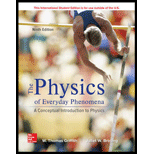
Concept explainers
Just as car A is starting up, it is passed by car B. Car B travels with a constant velocity of 7 m/s, while car A accelerates with a constant acceleration of 4.2 m/s2, starting from rest.
- a. Compute the distance traveled by each car for times of 1 s, 2 s, 3 s, and 4 s.
- b. At what time, approximately, does car A overtake car B?
- c. How might you go about finding this time exactly? Explain.
(a)
The distance travelled by the car at various times.
Answer to Problem 5SP
The distances travelled by the car at various times are calculated using Newton’s equations of motion.
Explanation of Solution
Given info: Velocity of the car B is 7 m/s and acceleration of car A is
Write the expression for distance.
Here,
v is the final velocity
t is the initial time
s is the distance
Car A starts from rest. Hence, initial velocity is zero. Car B travels with constant velocity. Hence, its acceleration is zero.
For Car A,
Write the expression for distance.
Here,
t is the initial time
s is the distance
a is the acceleration
At 1s,
Substitute 1s for t and
At 2s,
Substitute 2s for t and
At 3s,
Substitute 3s for t and
At 4s,
Substitute 4s for t and
For Car B,
Write the expression for distance.
Here,
t is the initial time
s is the distance
v is the velocity
At 1s,
Substitute 1s for t and 7 m/s for v to get s.
At 2s,
Substitute 2s for t and 7 m/s for v to get s.
At 3s,
Substitute 3s for t and 7 m/s for v to get s.
At 4s,
Substitute 4s for t and 7 m/s for v to get s.
Conclusion:
The distances travelled by the car at various times are calculated using Newton’s equations of motion.
(b)
The time when Car A overtakes Car B.
Answer to Problem 5SP
Car A overtakes Car B between the interval 3s and 4s.
Explanation of Solution
From (a), it can be observed that the distance travelled by car A is more than that of car B at 4s. Hence, it is evident that somewhere between 3s and 4s, car A must have overtaken car B.
Conclusion:
Car A overtakes Car B between the interval 3s and 4s.
(c)
The time at which car A overtakes car B.
Answer to Problem 5SP
The time at which car A overtakes car B is
Explanation of Solution
Given info: Velocity of the car B is 7 m/s and acceleration of car A is
Equate the expressions for distances travelled by car A and car B.
Re-arrange the above equation to get t.
Substitute 7 m/s for v and
Conclusion:
The time at which car A overtakes car B is
Want to see more full solutions like this?
Chapter 2 Solutions
Physics of Everyday Phenomena
- Lab 8 Part 3 PHET Wave Interface simulation. I am having trouble with this part of the lab.arrow_forwardMick and Rick are twins born on Earth in the year 2175. Rick grows up to be an Earth-bound robotics technician while Mick becomes an intergalactic astronaut. Mick leaves the Earth on his first space mission in the year 2200 and travels, according to his clock, for 10 years at a speed of 0.75c. Unfortunately, at this point in his journey, the structure of his ship undergoes mechanical breakdown and the ship explodes. How old is Rick when his brother dies?arrow_forwardHi, I have canceled, why did you charge me again?arrow_forward
 Physics for Scientists and Engineers: Foundations...PhysicsISBN:9781133939146Author:Katz, Debora M.Publisher:Cengage Learning
Physics for Scientists and Engineers: Foundations...PhysicsISBN:9781133939146Author:Katz, Debora M.Publisher:Cengage Learning Principles of Physics: A Calculus-Based TextPhysicsISBN:9781133104261Author:Raymond A. Serway, John W. JewettPublisher:Cengage Learning
Principles of Physics: A Calculus-Based TextPhysicsISBN:9781133104261Author:Raymond A. Serway, John W. JewettPublisher:Cengage Learning Glencoe Physics: Principles and Problems, Student...PhysicsISBN:9780078807213Author:Paul W. ZitzewitzPublisher:Glencoe/McGraw-Hill
Glencoe Physics: Principles and Problems, Student...PhysicsISBN:9780078807213Author:Paul W. ZitzewitzPublisher:Glencoe/McGraw-Hill University Physics Volume 1PhysicsISBN:9781938168277Author:William Moebs, Samuel J. Ling, Jeff SannyPublisher:OpenStax - Rice University
University Physics Volume 1PhysicsISBN:9781938168277Author:William Moebs, Samuel J. Ling, Jeff SannyPublisher:OpenStax - Rice University Physics for Scientists and Engineers, Technology ...PhysicsISBN:9781305116399Author:Raymond A. Serway, John W. JewettPublisher:Cengage Learning
Physics for Scientists and Engineers, Technology ...PhysicsISBN:9781305116399Author:Raymond A. Serway, John W. JewettPublisher:Cengage Learning College PhysicsPhysicsISBN:9781938168000Author:Paul Peter Urone, Roger HinrichsPublisher:OpenStax College
College PhysicsPhysicsISBN:9781938168000Author:Paul Peter Urone, Roger HinrichsPublisher:OpenStax College





